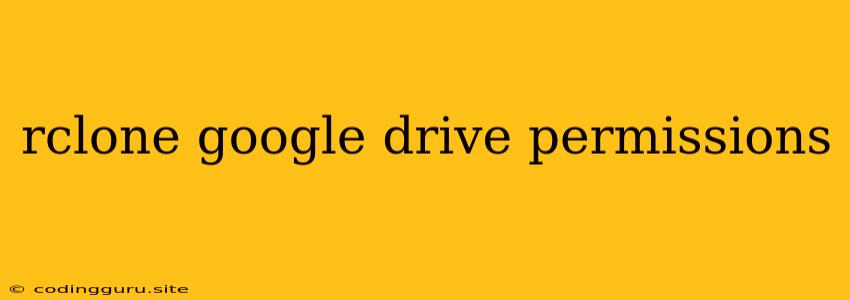rclone and Google Drive Permissions: A Detailed Guide
rclone is a versatile command-line tool that allows you to sync files between various cloud storage providers, including Google Drive. However, for rclone to function correctly with Google Drive, you need to grant it the necessary permissions. This article provides a comprehensive guide to understanding and managing rclone Google Drive permissions.
Why are Permissions Necessary?
When you use rclone to interact with Google Drive, you're essentially allowing the tool to access your account on your behalf. To safeguard your data and privacy, Google requires that you explicitly authorize rclone to perform certain actions, such as reading, writing, and deleting files in your Google Drive.
Understanding the Permission Scope
The level of access rclone needs depends on the tasks you intend to perform. Here's a breakdown of the different permission scopes:
- Read-only: This permission grants rclone the ability to view your files and folders but not modify them. This is sufficient for tasks like downloading files or syncing a read-only directory.
- Write: This permission allows rclone to create, edit, and delete files and folders in your Google Drive. This is essential for syncing directories that are modified frequently.
- Full access: This gives rclone complete control over your Google Drive account. It can perform all actions, including creating and deleting files and folders, sharing files, and managing your Drive settings.
How to Grant rclone Permissions:
-
Create a Google Cloud Project:
- Visit the Google Cloud Console and create a new project.
- Enable the Google Drive API within the project's APIs & Services section.
-
Generate API Credentials:
- Go to the Credentials section of your project.
- Create an OAuth 2.0 client ID.
- Select Desktop App as the application type.
- Enter a descriptive name for your client ID.
- Provide a redirect URI if needed (optional).
- Download the generated credentials file.
-
Configure rclone with Credentials:
- Open the rclone config file.
- Create a new remote named "google-drive" (or any name you prefer).
- Set the
typetogoogle-drive. - Specify the path to your downloaded credentials file in the
client_idandclient_secretfields. - You can also specify additional options like
scope(for limiting permissions) andteam_drive(for accessing team drives). - Save the configuration file.
-
Authorize rclone:
- When you first attempt to use rclone with your configured Google Drive remote, you'll be prompted to authorize rclone to access your account.
- Follow the instructions provided by rclone to grant the required permissions.
- Once authorized, you'll receive an access token that rclone will use to communicate with Google Drive.
Tips for Managing Permissions:
- Limit Permission Scope: Only grant rclone the permissions it absolutely needs. This minimizes the risk of unintended actions.
- Use Separate Google Accounts: Consider creating a separate Google account solely for rclone use. This isolates your personal data and limits the impact of any potential issues.
- Review rclone Logs: Monitor the logs generated by rclone to identify any potential issues related to permissions.
- Revoke Permissions: You can easily revoke rclone's permissions from your Google account at any time. Simply delete the corresponding client ID from the Google Cloud Console.
Example Scenarios:
- Downloading Files: If you only need to download files from Google Drive, the read-only permission is sufficient.
- Syncing a Local Folder: For syncing a local directory with Google Drive, the write permission is required.
- Managing Team Drives: For managing files in shared team drives, you might need full access depending on the specific actions you plan to perform.
Troubleshooting Permission Issues:
If you encounter problems with rclone and Google Drive permissions, try these troubleshooting steps:
- Verify Credentials: Ensure that the client ID and secret are correctly configured in your rclone config file.
- Revoke and Re-Authorize: Revoke permissions for rclone and then re-authorize it. This can sometimes resolve issues related to outdated tokens.
- Enable Less Secure App Access: While not recommended, you can temporarily enable "Less Secure App Access" in your Google account settings. However, this is only a temporary solution and should be disabled once the issue is resolved.
- Check Google Drive API Limits: If you're using rclone extensively, make sure you're not exceeding any API limits imposed by Google.
Conclusion:
Understanding rclone Google Drive permissions is crucial for using the tool effectively and securely. By following these guidelines, you can ensure that rclone has the necessary access to perform its tasks while maintaining the security and privacy of your Google Drive data. Remember to carefully consider the level of permissions you grant, monitor rclone logs, and be proactive in managing access.
